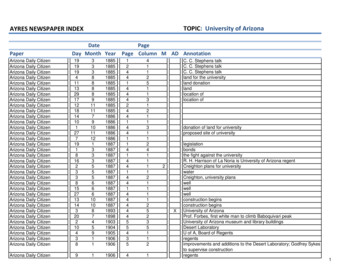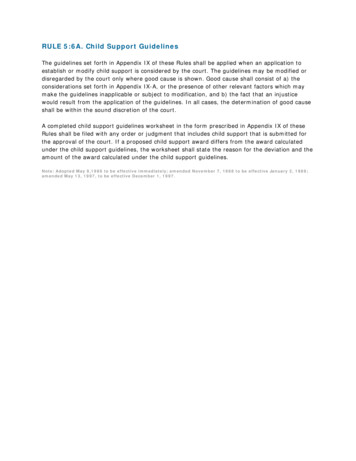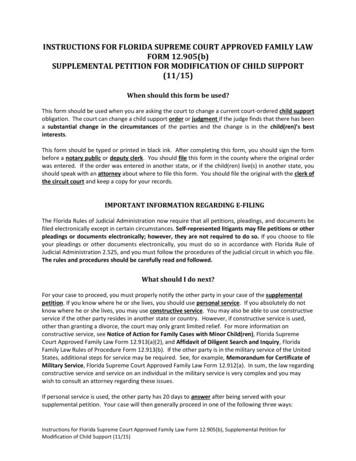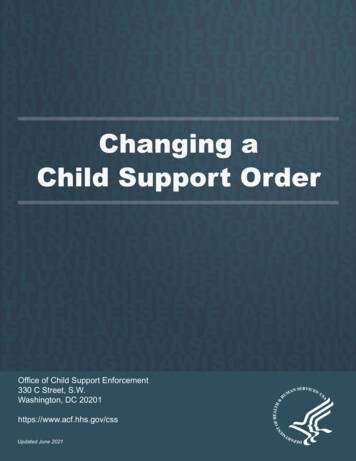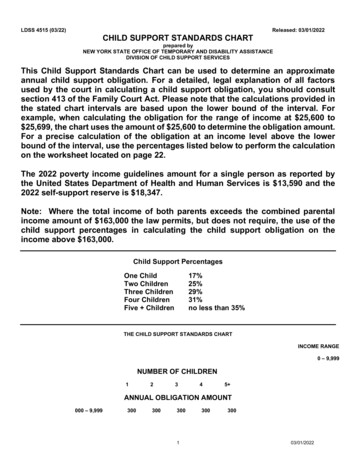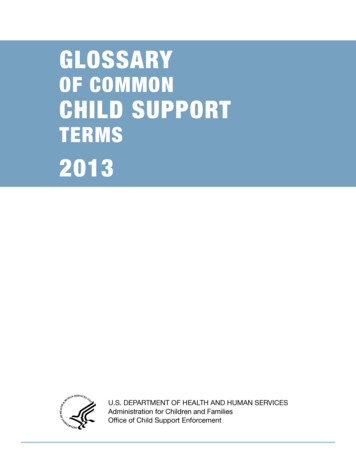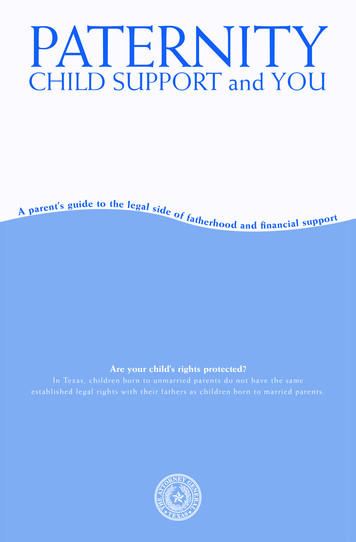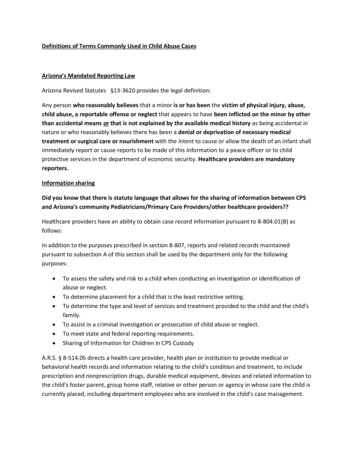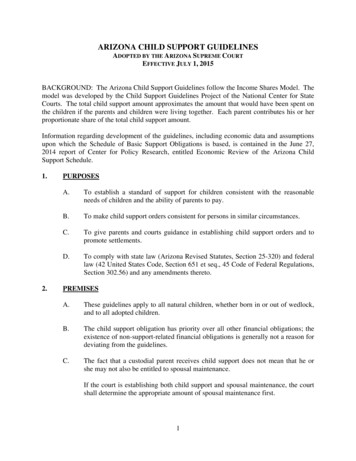
Transcription
ARIZONA CHILD SUPPORT GUIDELINESADOPTED BY THE ARIZONA SUPREME COURTEFFECTIVE JULY 1, 2015BACKGROUND: The Arizona Child Support Guidelines follow the Income Shares Model. Themodel was developed by the Child Support Guidelines Project of the National Center for StateCourts. The total child support amount approximates the amount that would have been spent onthe children if the parents and children were living together. Each parent contributes his or herproportionate share of the total child support amount.Information regarding development of the guidelines, including economic data and assumptionsupon which the Schedule of Basic Support Obligations is based, is contained in the June 27,2014 report of Center for Policy Research, entitled Economic Review of the Arizona ChildSupport Schedule.1.2.PURPOSESA.To establish a standard of support for children consistent with the reasonableneeds of children and the ability of parents to pay.B.To make child support orders consistent for persons in similar circumstances.C.To give parents and courts guidance in establishing child support orders and topromote settlements.D.To comply with state law (Arizona Revised Statutes, Section 25-320) and federallaw (42 United States Code, Section 651 et seq., 45 Code of Federal Regulations,Section 302.56) and any amendments thereto.PREMISESA.These guidelines apply to all natural children, whether born in or out of wedlock,and to all adopted children.B.The child support obligation has priority over all other financial obligations; theexistence of non-support-related financial obligations is generally not a reason fordeviating from the guidelines.C.The fact that a custodial parent receives child support does not mean that he orshe may not also be entitled to spousal maintenance.If the court is establishing both child support and spousal maintenance, the courtshall determine the appropriate amount of spousal maintenance first.1
The receipt or payment of spousal maintenance shall be treated in accordancewith sections 5.A and 6.A. The addition to or adjustment from gross income underthese sections shall apply for the duration of the spousal maintenance award.D.A parent's legal duty is to support his or her natural or adopted children. The"support" of other persons such as stepchildren or parents is deemed voluntaryand is not a reason for an adjustment in the amount of child support determinedunder the guidelines.E.In appropriate cases, a custodial parent may be ordered to pay child support.F.Monthly figures are used to calculate the child support obligation. Anyadjustments to the child support amount shall be annualized so that each month’schild support obligation is increased or decreased in an equal amount, instead ofthe obligation for particular months being abated, increased or decreased.EXAMPLE: At a child support hearing in a paternity action a custodial parentrequests an adjustment for childcare costs (Section 9.B.1.). The parent incurschildcare costs of 150 per month but only for nine months of the year. Theadjustment for childcare costs must be annualized as follows: Multiply the 150monthly cost times the nine months that the cost is actually paid each year, for anannual total of 1,350. Divide this total by 12 months to arrive at an annualizedmonthly adjustment of 113 that may be added to the Basic Child SupportObligation when determining the child support order.G.3.When determining the Basic Child Support Obligation under Section 8, theamount derived from the Schedule of Basic Child Support Obligations shall notbe less than the amount indicated on the Schedule:1.For six children where there are more than six children.2.For the Combined Adjusted Gross Income of 20,000 where the actualCombined Adjusted Gross Income of the parents is greater than 20,000.PRESUMPTIONIn any action to establish or modify child custody, and in any action to establish childsupport or past support or to modify child support, whether temporary or permanent,local or interstate, the amount resulting from application of these guidelines shall be theamount of child support ordered. These include, without limitation, all actions orproceedings brought under Title 25 of the Arizona Revised Statutes (including maternityand paternity) and juvenile court actions in which a child support order is established ormodified. However, if application of the guidelines would be inappropriate or unjust in aparticular case, the court shall deviate from the guidelines in accordance with Section 20.2
4.DURATION OF CHILD SUPPORTDuration of child support is governed by Arizona Revised Statutes, Sections 25-320 and25-501, except as provided in Arizona Revised Statutes, Section 25-1304.Upon entry of an initial or modified child support order, the court shall, or in anysubsequent action relating to the child support order, the court may, establish apresumptive date for the termination of the current child support obligation. Thepresumptive termination date shall be the last day of the month of the 18th birthday of theyoungest child included in the order unless the court finds that it is projected that theyoungest child will not complete high school by age 18. In that event, the presumptivetermination date shall be the last day of the month of the anticipated graduation date orage 19, whichever occurs first. The administrative income withholding order issued bythe department or its agent in Title IV-D cases and an Order of Assignment issued by thecourt shall include the presumptive termination date. The presumptive date may bemodified upon changed circumstances.An employer or other payor of funds honoring an Order of Assignment or anadministrative income withholding order that includes the presumptive termination dateand is for current child support only, shall discontinue withholding monies after the lastpay period of the month of the presumptive termination date. If the Order of Assignmentor administrative income withholding order includes current child support and arrearagepayment, the employer or other payor of funds shall continue withholding the entireamount listed on the Order of Assignment or administrative income withholding orderuntil further order.For purposes of determining the presumptive termination date, it is further presumed:5.A.That a child not yet in school will enter 1st grade if the child reaches age 6 on orbefore September 1 of the year in which the child reaches age 6; otherwise, it ispresumed that the child will enter 1st grade the following year; and,B.That a child will graduate in the month of May after completing the 12th grade.DETERMINATION OF THE GROSS INCOME OF THE PARENTSNOTE: Terms such as "Gross Income" and "Adjusted Gross Income" as used in theseguidelines do not have the same meaning as when they are used for tax purposes.A.Gross income includes income from any source, and may include, but is notlimited to, income from salaries, wages, commissions, bonuses, dividends,severance pay, pensions, interest, trust income, annuities, capital gains, socialsecurity benefits (subject to Section 26), worker's compensation benefits,unemployment insurance benefits, disability insurance benefits, recurring gifts,prizes, and spousal maintenance. Cash value shall be assigned to in-kind or othernon-cash benefits. Seasonal or fluctuating income shall be annualized. Income3
from any source which is not continuing or recurring in nature need notnecessarily be deemed gross income for child support purposes. Generally, thecourt should not attribute income greater than what would have been earned fromfull-time employment. Each parent should have the choice of working additionalhours through overtime or at a second job without increasing the child supportaward. The court may, however, consider income actually earned that is greaterthan would have been earned by full-time employment if that income washistorically earned from a regular schedule and is anticipated to continue into thefuture.The court should generally not attribute additional income to a parent if thatwould require an extraordinary work regimen. Determination of what constitutesa reasonable work regimen depends upon all relevant circumstances including thechoice of jobs available within a particular occupation, working hours andworking conditions.B.Gross income does not include sums received as child support or benefits receivedfrom means-tested public assistance programs including, but not limited to,Temporary Assistance to Needy Families (TANF), Supplemental Security Income(SSI), Nutrition Assistance and General Assistance.C.For income from self-employment, rent, royalties, proprietorship of a business, orjoint ownership of a partnership or closely held corporation, gross income meansgross receipts minus ordinary and necessary expenses required to produceincome. Ordinary and necessary expenses do not include amounts determined bythe court to be inappropriate for determining gross income for purposes of childsupport. Ordinary and necessary expenses include one-half of theself-employment tax actually paid.D.Expense reimbursements or benefits received by a parent in the course ofemployment or self-employment or operation of a business shall be counted asincome if they are significant and reduce personal living expenses.E.If a parent is unemployed or working below full earning capacity, the court mayconsider the reasons. If earnings are reduced as a matter of choice and not forreasonable cause, the court may attribute income to a parent up to his or herearning capacity. If the reduction in income is voluntary but reasonable, the courtshall balance that parent's decision and benefits therefrom against the impact thereduction in that parent's share of child support has on the children's best interest.In accordance with Arizona Revised Statutes Section 25-320, income of at leastminimum wage shall be attributed to a parent ordered to pay child support. Ifincome is attributed to the parent receiving child support, appropriate childcareexpenses may also be attributed.4
The court may decline to attribute income to either parent. Examples of cases inwhich it may be inappropriate to attribute income include, but are not limited to,the following circumstances:6.1.A parent is physically or mentally disabled,2.A parent is engaged in reasonable career or occupational training toestablish basic skills or reasonably calculated to enhance earning capacity,3.Unusual emotional or physical needs of a natural or adopted child requirethat parent’s presence in the home, or4.The parent is a current recipient of Temporary Assistance to NeedyFamilies.F.Only income of persons having a legal duty of support shall be treated as incomeunder the guidelines. For example, income of a parent's new spouse is not treatedas income of that parent.G.The court shall not take into account the impact of the disposition of maritalproperty except as provided in Arizona Revised Statutes Section 25-320.A.6.(".excessive or abnormal expenditures, destruction, concealment or fraudulentdisposition of community, joint tenancy and other property held in common.") orto the extent that such property generates income to a parent.H.The Schedule of Basic Child Support Obligations is based on net income andconverted to gross income for ease of application. The impact of income taxes hasbeen considered in the Schedule (Federal Tax including Earned Income TaxCredit, Arizona State Tax, and FICA).ADJUSTMENTS TO GROSS INCOMEFor purposes of this section, “children of other relationships” means natural or adoptedchildren who are not the subject of this particular child support determination.Adjustments to gross income for other support obligations are made as follows:A.The court-ordered amount of spousal maintenance resulting from this or any othermarriage, if actually being paid, shall be deducted from the gross income of theparent paying spousal maintenance. Court-ordered arrearage payments shall notbe included as an adjustment to gross income.B.The court-ordered amount of child support for children of other relationships, ifactually being paid, shall be deducted from the gross income of the parent payingthat child support. Court-ordered arrearage payments shall not be included as anadjustment to gross income.5
C.An amount shall be deducted from the gross income of a parent for children ofother relationships covered by a court order for whom they are the custodialparent. The amount of the adjustment shall be determined by a simplifiedapplication of the guidelines (defined in example below).D.An amount may be deducted from the gross income of a parent for support ofnatural or adopted children of other relationships not covered by a court order.The amount of any adjustment shall not exceed the amount arrived at by asimplified application of the guidelines (defined in example below).EXAMPLE: A parent having gross monthly income of 2,000 supports a naturalor adopted minor child who is not the subject of the child support case before thecourt and for whom no child support order exists. To use the SimplifiedApplication of the Guidelines, locate 2,000 in the Combined Adjusted GrossIncome column of the Schedule. Select the amount in the column for one child, 415. The parent's income may be reduced up to 415, resulting in an AdjustedGross Income of 1,585.7.DETERMINING THE ADJUSTED GROSS INCOME OF THE PARENTSAdjusted Gross Income is gross income minus the adjustments provided in Section 6 ofthese guidelines. The Adjusted Gross Income for each parent shall be established. Theseamounts shall be added together. The sum is the Combined Adjusted Gross Income.8.DETERMINING THE BASIC CHILD SUPPORT OBLIGATIONLocate the income closest to the parents' Combined Adjusted Income figure on theSchedule of Basic Child Support Obligations and select the column for the number ofchildren involved. This number is the Basic Child Support Obligation. If the parents’income falls exactly in between two combined adjusted gross income amounts, round upto the nearest combined adjusted income entry on the schedule of basic child supportobligations.EXAMPLE: the combined adjusted gross income of the parents’ is 8,125 which isexactly between 8,100 and 8,150. Round up to the nearest combined adjusted incomeentry of 8,150 and use this amount as the basic child support obligation.If there are more than six children, the amount derived from the schedule of basic supportobligations for six children shall be the presumptive amount. The party seeking a greatersum shall bear the burden of proof that the needs of the children require a greater sum.If the combined adjusted gross income of the parties is greater than 20,000 per month,the amount set forth for combined adjusted gross income of 20,000 shall be thepresumptive Basic Child Support Obligation. The party seeking a sum greater than thispresumptive amount shall bear the burden of proof to establish that a higher amount is in6
the best interests of the children, taking into account such factors as the standard of livingthe children would have enjoyed if the parents and children were living together, theneeds of the children in excess of the presumptive amount, consideration of anysignificant disparity in the respective percentages of gross income for each party and anyother factors which, on a case by case basis, demonstrate that the increased amount isappropriate.9.DETERMINING THE TOTAL CHILD SUPPORT OBLIGATIONTo determine the Total Child Support Obligation, the court:A.Shall add to the Basic Child Support Obligation the cost of the children's medicaldental or vision insurance coverage, if any (this provision does not imply anyobligation of either parent to provide dental or vision insurance). In determiningthe amount to be added, only the amount of the insurance cost attributable to thechildren subject of the child support order shall be included. If coverage isapplicable to other persons, the total cost shall be prorated by the number ofpersons covered. The court may decline to credit a parent for medical, dental orvision insurance coverage obtained for the children if the coverage is not valid inthe geographic region where the children reside.EXAMPLE: Through an employment-related insurance plan, a parent providesmedical insurance that covers the parent, one child subject of the child supportcase and two other children. Under the plan, the cost of an employee's individualinsurance coverage would be 120. This parent instead pays a total of 270 forthe "family option" that provides coverage for the employee and any number ofdependents. Calculate the adjustment for medical insurance as follows: Subtractthe 120 cost of individual coverage from the 270 paid for the "family option" tofind the cost of dependent coverage. The 150 remainder then is divided by three- the number of covered dependents. The resulting 50 is added to the Basic ChildSupport Obligation as the cost of medical insurance coverage for the one child.An order for child support shall assign responsibility for providing medicalinsurance for the children who are the subject of the child support order. Ifmedical insurance of comparable benefits and cost is available to both parents, thecourt should assign the responsibility to the parent having primary physicalcustody.The court shall also specify the percentage that each parent shall pay for anymedical, dental or vision costs of the children which are not covered by insurance.For purposes of this paragraph, non-covered "medical" means medicallynecessary medical, dental or vision care as defined by Internal Revenue ServicePublication 502.Except for good cause shown, any request for payment or reimbursement ofuninsured medical, dental or vision costs must be provided to the other parent7
within 180 days after the date the services occur. The parent responsible forpayment or reimbursement must pay his or her share, as ordered by the court, ormake acceptable payment arrangements with the provider or person entitled toreimbursement within 45 days after receipt of the request.Both parents should use their best efforts to obtain services that are covered by theinsurance. A parent who is entitled to receive reimbursement from the otherparent for medical costs not covered by insurance shall, upon request of the otherparent, provide receipts or other evidence of payments actually made.B.May add to the Basic Child Support Obligation amounts for any of the following:1. Childcare CostsChildcare expenses that would be appropriate to the parents' financialabilities.Expenses for childcare shall be annualized in accordance with Section 2.F.A custodial parent paying for childcare may be eligible for a credit fromfederal tax liability for childcare costs for dependent children. Thecustodial parent is the parent who has physical custody of the children forthe greater part of the year. In an equal physical custody situation, neitherparent shall be entitled to the credit for purposes of calculating childsupport. Before adding childcare costs to the Basic Child SupportObligation, the court may adjust this cost in order to apportion the benefitthat the dependent tax credit will have to the parent incurring the childcarecosts.At lower income levels the head of household does not incur sufficient taxliability to benefit from the federal childcare tax credit. No adjustmentshould be made where the income of the custodial parent is less thanindicated on the following chart:MONTHLY GROSS INCOME OF THECUSTODIAL PARENTONE CHILD 2,600TWO CHILDREN 3,100THREE CHILDREN 3,400FOUR CHILDREN 3,550FIVE CHILDREN 3,650SIX CHILDREN 3,8008
If the custodial parent’s income is greater than indicated on the abovechart, the court may adjust this cost for the federal childcare tax credit ifthe credit is actually claimed or will be claimed.For one child with monthly childcare costs exceeding 200, deduct 50from the monthly childcare amount. For two or more children with totalmonthly childcare costs exceeding 400, deduct 100 from the monthlychildcare amount. See Example One.For one child with monthly childcare costs of 200 or less, deduct 25%from the monthly childcare amount. For two or more children with totalmonthly childcare costs of 400 or less, deduct 25% from the monthlychildcare amount. See Example Two.EXAMPLE ONE: For two children a parent pays monthly childcare costsof 550 for nine months of the year. To adjust for the expected tax creditbenefit, first determine whether the average costs of childcare exceeds 400 per month. In this example, because the average cost of 413 ( 550multiplied by 9 months, divided by 12 months) exceeds the 400maximum for two or more children, 100 per month may be subtractedfrom the average monthly cost. 313 ( 413 - 100) may be added to theBasic Child Support Obligation for adjusted childcare costs.EXAMPLE TWO: A parent pays monthly childcare costs of 175 for onechild. Because this amount is less than the 200 maximum for one child,multiply 175 by 25% ( 175 multiplied by 25% 44). Subtract theadjustment from the monthly average ( 175 - 44 131). The adjustedamount of 131 may be added to the Basic Child Support Obligation.Any adjustment for the payment of childcare costs with pre-tax dollarsshall be calculated in a similar manner. A percentage adjustment otherthan twenty-five percent may be utilized if proven by the parent paying thechildcare costs.2. Education ExpensesAny reasonable and necessary expenses for attending private or specialschools or necessary expenses to meet particular educational needs of achild, when such expenses are incurred by agreement of both parents orordered by the court.3. Extraordinary ChildThese guidelines are designed to fit the needs of most children. The courtmay increase the Basic Child Support Obligation to provide for the specialneeds of gifted or handicapped children.9
4. Older Child AdjustmentThe average expenditures for children age 12 or older exceed the averageexpenditures for all children by approximately 10%. Therefore, the courtmay increase child support for a child who has reached the age of 12 yearsby an amount up to 10% of the child support shown on the Schedule. If thecourt chooses to make an adjustment, the following method of calculationshall be used.EXAMPLE: The Basic Child Support Obligation for one child, age 12, is 459. As much as 46 may be added to the basic child support obligation,for a total of 505. If not all children subject to the order are age 12 orover, the increase will be prorated as follows: assume the Basic ChildSupport Obligation for three children is 786. If one of the three childrenis age 12 or over, assign 1/3 of the Basic Child Support Obligation to theolder child ( 262). Up to 10% ( 26) of that portion of the Basic ChildSupport Obligation may be added as an older child adjustment, increasingthe obligation to 812. NOTE: This prorating method is limited to thissection and should not be followed in Section 25.10.DETERMINING EACH PARENT'S PROPORTIONATE SHARE OF THETOTAL CHILD SUPPORT OBLIGATIONThe Total Child Support Obligation shall be divided between the parents in proportion totheir Adjusted Gross Incomes. The obligation of each parent is computed by multiplyingeach parent's share of the Combined Adjusted Gross Income by the Total Child SupportObligation.EXAMPLE: Combined Adjusted Gross Income is 1,000. The father's Adjusted GrossIncome is 600. Divide the father's Adjusted Gross Income by the Combined AdjustedIncome. The result is the father's share of the Combined Adjusted Gross Income. ( 600divided by 1,000 60%). The father's share is 60%; the mother's share is 40%.11.ADJUSTMENT FOR COSTS ASSOCIATED WITH PARENTING TIMEBecause the Schedule of Basic Child Support Obligations is based on expenditures forchildren in intact households, there is no consideration for costs associated with parentingtime. When parenting time is exercised by the noncustodial parent, a portion of the costsfor children normally expended by the custodial parent shifts to the noncustodial parent.Accordingly, unless it is apparent from the circumstances that the noncustodial parentwill not incur costs for the children during parenting time, when proof establishes thatparenting time is or is expected to be exercised by the noncustodial parent, an adjustmentshall be made to that parent's proportionate share of the Total Child Support Obligation.To calculate child support in equal custody cases, see Section 12.10
For purposes of calculating parenting time days, only the time spent by a child with thenoncustodial parent is considered. Time that the child is in school or childcare is notconsidered.To adjust for the costs of parenting time, first determine the total annual amount ofparenting time indicated in a court order or parenting plan or by the expectation orhistorical practice of the parents. Using the following definitions, add together each blockof parenting time to arrive at the total number of parenting time days per year. Calculatethe number of parenting time days arising from any block of time the child spends withthe noncustodial parent in the following manner:A.Each block of time begins and ends when the noncustodial parent receives orreturns the child from the custodial parent or from a third party with whom thecustodial parent left the child. Third party includes, for example, a school orchildcare provider.B.Count one day of parenting time for each 24 hours within any block of time.C.to the extent there is a period of less than 24 hours remaining in the block of time,after all 24-hour days are counted or for any block of time which is in total lessthan 24 hours in duration:1.A period of 12 hours or more counts as one day.2.A period of 6 to 11 hours counts as a half-day.3.A period of 3 to 5 hours counts as a quarter-day.4.Periods of less than 3 hours may count as a quarter-day if, during thosehours, the noncustodial parent pays for routine expenses of the child, suchas meals.EXAMPLES:1.Noncustodial parent receives the child at 9:00 p.m. on Thursday eveningand brings the child to school at 8:00 a.m. on Monday morning, fromwhich custodial parent picks up the child at 3:00 p.m. on Monday.a.b.c.2.9:00 p.m. Thursday to 9:00 p.m. Sunday is three days.9:00 p.m. Sunday to 8:00 a.m. Monday is 11 hours, which equals ahalf day.Total is 3 ½ days.Noncustodial parent picks the child up from school at 3:00 p.m. Fridayand returns the child to school at 8:00 a.m. on Monday.11
a.b.c.3.3:00 p.m. Friday to 3:00 p.m. Sunday is two days.3:00 p.m. Sunday to 8:00 a.m. Monday is 17 hours, which equalsone day.Total is 3 days.Noncustodial parent picks up child from soccer at noon on Saturday, andreturns the child to custodial parent at 9:00 p.m. on Sunday.a.b.c.Noon Saturday to noon Sunday is one day.Noon Sunday to 9:00 p.m. Sunday is 9 hours, which equals ½ day.Total is 1 ½ days.After determining the total number of parenting time days, refer to “Parenting TimeTable A" below. The left column of the table sets forth numbers of parenting time days inincreasingly higher ranges. Adjacent to each range is an adjustment percentage. Theparenting time adjustment is calculated as follows: locate the total number of parentingtime days per year in the left column of “Parenting Time Table A" and select theadjustment percentage from the adjacent column. Multiply the Basic Child SupportObligation determined under Section 8 by the appropriate adjustment percentage. Thenumber resulting from this multiplication then is subtracted from the proportionate shareof the Total Child Support Obligation of the parent who exercises parenting time.PARENTING TIMETABLE ANumber ofAdjustmentParenting TimePercentageDays0-304 - 20.01221 - 38.03139 - 57.05058 - 72.08573 - 87.10588 - 115.161116 - 129.195130 - 142.253143 - 152.307153 - 162.362163 - 172.422173 - 182.48612
EXAMPLE: The Basic Child Support Obligation from the Schedule is 667 for twochildren. After making all applicable adjustments under Section 9, such as an adjustmentfor one older child, the Total Child Support Obligation is 700 and the noncustodialparent's proportionate share is 60%, or 421. The noncustodial parent has parenting timewith the children a total of 100 days. On Parenting Time Table A, the range of days forthis amount of parenting time is from 88 to 115 days. The corresponding adjustmentpercentage is .161. Multiply the 667 Basic Child Support Obligation by .161 or 16.1%.The resulting 107 is subtracted from 421 (the noncustodial parent's proportionate shareof the Total Child Support Obligation), adjusting the child support obligation to 313.As the number of parenting time days approaches equal time sharing (143 days andabove), certain costs usually incurred only in the custodial household are assumed to besubstantially or equally shared by both parents. These costs are for items such as thechild's clothing and personal care items, entertainment and reading materials. If thisassumption is rebutted by proof, for example, that such costs are not substantially orequally shared in each household, only Parenting Time Table B must be used to calculatethe parenting time adjustment for this range of days. Locate the total number of parentingtime days per year in the left columns of “Parenting Time Table B" and select theadjustment percentage from the adjacent column. Multiply the Basic Child SupportObligation determined under Section 8 by the appropriate adjustment percentage. Thenumber resulting from this multiplication then is subtracted from the proportionate shareof the Total Child Support Obligation of the parent who exercises parenting time.PARENTING TIMETABLE BNumber ofAdjustmentParenting Time DaysPercentage143 – 152.27512.153 – 162.293163 – 172.312173 – 182.331EQUAL CUSTODYIf the time spent with each parent is essentially equal, the expenses for the children areequally shared and adjusted gross incomes of the
ARIZONA CHILD SUPPORT GUIDELINES . A. DOPTED BY THE . A. RIZONA . S. UPREME . C. OURT. E. FFECTIVE . J. ULY . 1, 2015. BACKGROUND: The Arizona Child Support .
